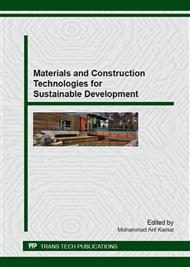p.17
p.31
p.47
p.63
p.77
p.89
p.97
p.107
p.123
Material Characteristics and Building Physics for Energy Efficiency
Abstract:
Current modern technology in construction can dramatically reduce energy consumed in buildings for mechanical heating and cooling. The application of the latest advancements in various technologies including developments in material science, and using environment friendly building materials is of prime concern. The reductions in building envelope heat losses combined with optimized material configuration and the proper amount of thermal insulation and thermal mass in the building envelope help to reduce the building cooling and heating energy demands and building related CO2 emission into the atmosphere. The selection of appropriate building material helps us to use the energy efficiently. This paper presents a brief study about the building physics and material characteristics that helps in selecting proper building materials.
Info:
Periodical:
Pages:
77-87
Citation:
Online since:
October 2015
Authors:
Price:
Сopyright:
© 2016 Trans Tech Publications Ltd. All Rights Reserved
Share:
Citation:


